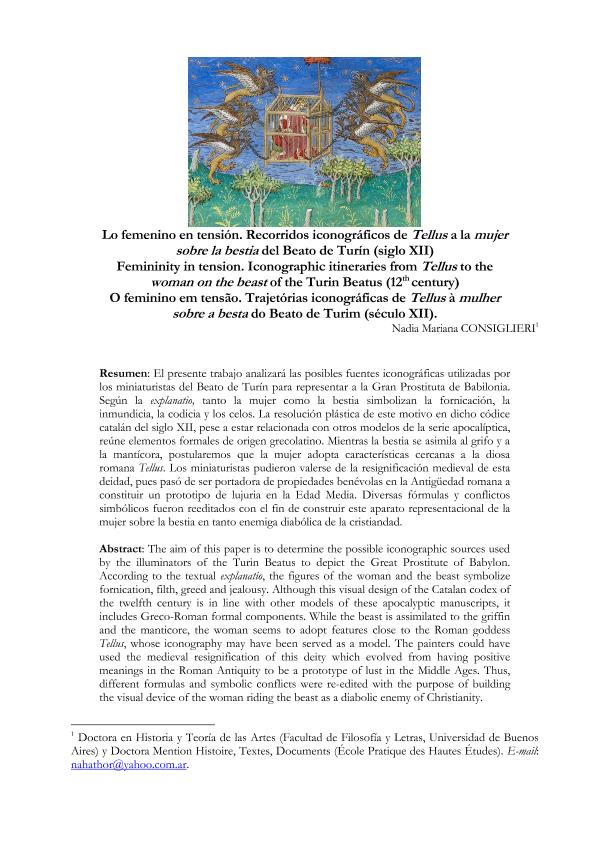Mostrar el registro sencillo del ítem
dc.contributor.author
Consiglieri, Nadia Mariana

dc.date.available
2022-09-21T15:52:04Z
dc.date.issued
2020-06
dc.identifier.citation
Consiglieri, Nadia Mariana; Lo femenino en tensión: Recorridos iconográficos de Tellus a la mujer sobre la bestia del Beato de Turín (siglo XII); Universitat Autònoma de Barcelona. Institut d'Estudis Medievals; Mirabilia; 12; 1; 6-2020; 10-38
dc.identifier.issn
1676-5818
dc.identifier.uri
http://hdl.handle.net/11336/169770
dc.description.abstract
El presente trabajo analizará las posibles fuentes iconográficas utilizadas porlos miniaturistas del Beato de Turín para representar a la Gran Prostituta de Babilonia.Según la explanatio, tanto la mujer como la bestia simbolizan la fornicación, lainmundicia, la codicia y los celos. La resolución plástica de este motivo en dicho códicecatalán del siglo XII, pese a estar relacionada con otros modelos de la serie apocalíptica,reúne elementos formales de origen grecolatino. Mientras la bestia se asimila al grifo y ala mantícora, postularemos que la mujer adopta características cercanas a la diosaromana Tellus. Los miniaturistas pudieron valerse de la resignificación medieval de estadeidad, pues pasó de ser portadora de propiedades benévolas en la Antigüedad romana aconstituir un prototipo de lujuria en la Edad Media. Diversas fórmulas y conflictossimbólicos fueron reeditados con el fin de construir este aparato representacional de lamujer sobre la bestia en tanto enemiga diabólica de la cristiandad.
dc.description.abstract
The aim of this paper is to determine the possible iconographic sources used by the illuminators of the Turin Beatus to depict the Great Prostitute of Babylon. According to the textual explanatio, the figures of the woman and the beast symbolize fornication, filth, greed and jealousy. Although this visual design of the Catalan codex of the twelfth century is in line with other models of these apocalyptic manuscripts, it includes Greco-Roman formal components. While the beast is assimilated to the griffin and the manticore, the woman seems to adopt features close to the Roman goddess Tellus, whose iconography may have been served as a model. The painters could have used the medieval resignification of this deity which evolved from having positive meanings in the Roman Antiquity to be a prototype of lust in the Middle Ages. Thus, different formulas and symbolic conflicts were re-edited with the purpose of building the visual device of the woman riding the beast as a diabolic enemy of Christianity.
dc.format
application/pdf
dc.language.iso
spa
dc.publisher
Universitat Autònoma de Barcelona. Institut d'Estudis Medievals
dc.rights
info:eu-repo/semantics/openAccess
dc.rights.uri
https://creativecommons.org/licenses/by-nc-sa/2.5/ar/
dc.subject
PROSTITUTA DE BABILONIA Y BESTIA
dc.subject
BEATO DE TURÍN
dc.subject
TELLUS
dc.subject
MANTÍCORA
dc.subject.classification
Arte, Historia del Arte

dc.subject.classification
Arte

dc.subject.classification
HUMANIDADES

dc.title
Lo femenino en tensión: Recorridos iconográficos de Tellus a la mujer sobre la bestia del Beato de Turín (siglo XII)
dc.title
Femininity in tension: Iconographic itineraries from Tellus to the woman on the beast of the Turin Beatus (12th century)
dc.title
O feminino em tensão: Trajetórias iconográficas de Tellus à mulher sobre a besta do Beato de Turim (século XII)
dc.type
info:eu-repo/semantics/article
dc.type
info:ar-repo/semantics/artículo
dc.type
info:eu-repo/semantics/publishedVersion
dc.date.updated
2022-09-19T15:03:17Z
dc.journal.volume
12
dc.journal.number
1
dc.journal.pagination
10-38
dc.journal.pais
España

dc.journal.ciudad
Barcelona
dc.description.fil
Fil: Consiglieri, Nadia Mariana. Consejo Nacional de Investigaciones Científicas y Técnicas; Argentina. Universidad de Buenos Aires. Facultad de Filosofía y Letras; Argentina
dc.journal.title
Mirabilia

dc.relation.alternativeid
info:eu-repo/semantics/altIdentifier/url/https://www.revistamirabilia.com/ars/issues/mirabilia-ars-12-2020-1
Archivos asociados
